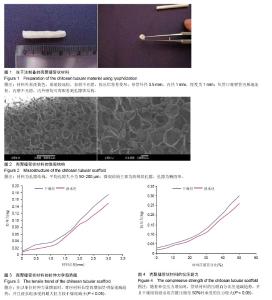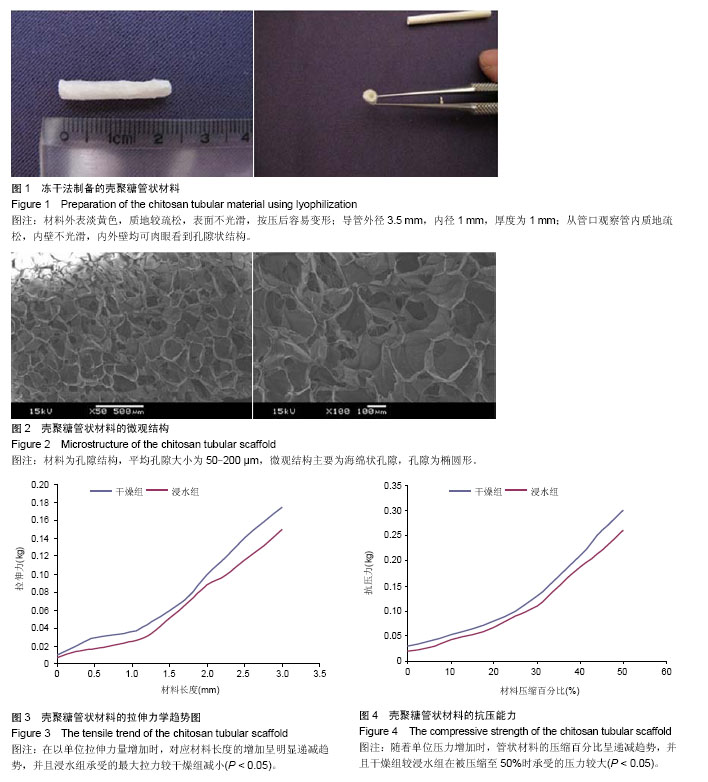| [1] Weber RA,Breidenbach WC,Brown RE,et al. A randomized study of polyglycolic acid conduits for digital nerve reconstruction in humans. Plast Reconstr Surg. 2000; 106: 1036.
[2] Keilhoff G,Goihl A,Stang F,et al.Peripheral nerve tissue engineering: autologous Schwan cells VS transdifferentiated mesenchymal stem cells.Tissue Eng. 2006;12(6):1451.
[3] de Ruiter GC,Malessy MJ,Yaszemski MJ,et al.Desighning ideal conduits for peripheral nerve repair.Neurosurg Focus. 2009;26(2):1.
[4] Cheng H,Huang YC,Chang PT,et al.Laminin-incorporated nerve conduits made by plasma treatment for repairing spinal cord injury.Bioehem Biophys Res Commun. 2007;357(4): 938-994.
[5] Li X,Yang Z,Zhang A,et al.Repair of thoracic spinal cord injury by chitosan tube implantation in adult rats. Biomaterials. 2009; 30(6):1121-1132.
[6] Lu JX,Prudhommeaux F,Meunier A,et al.Effect of chitosan on rat knee cartilages.Biomaterials.1999;20(20):1937-1944.
[7] Yamane S,Iwasaki N,Majima T,et al.Feasibility of chitosan-based hyaluronic acid hybridbiomaterial for a novel scaffold in cartilage tissue engineering. Biomaterials. 2005; 26(6):611-619.
[8] Xia W,Liu W,Cui L,et al.Tissue engineering of cartilage with the use of chitosan-gelation complex scaffolds.JBiomed Mater Ras B Appl Biomater.2004;71(2):373-380.
[9] Mi FL,Shyu SS,Wu YB,et alFrarication and characterization of asponge-like asymmetricchitosan membrane as a wound dressing.Biomaterials.2001;22:165-173.
[10] Kong M,Chen XG,Xing K,et alAntimicrobial properties of chitosan and mode of action: a state of the art review.Int J Food Microbiol.2010;144:51-63.
[11] Sashiwa H, Aiba S.Chemically modified chitin and chitosan as biomaterials. Prog Polym Sci.2004;29:887-908.
[12] No HK,Young Park N,Ho Lee S,et al.Antibacterial activity of chitosans and chitosan oligomers with different molecular weights.Int J Food Microbiol.2002;74(1-2):65-72.
[13] Sogias IA,Khutoryanskiy VV,Williams AC.Exploring the factors affecting the solubility of chitosan in water.Macromol Chem Phys.2010;211:426-433.
[14] Torres-Giner S, Ocio M, Lagaron J. Development of active antimicrobial fiberbased chitosan polysaccharide nanostructures using electrospinning.Eng Life Sci. 2008;8: 303-314.
[15] Wang JW,Hon MH. Preparation and Characterization of pH Sensitive Sugar Mediated (polyethyleneglycol/chitosan) Membrane.J Mater Sci Mater Med.2003;14(12):1079-1088.
[16] Rinki M, Dutta PK.Chitosan Based Scaffolds by Lyophilization and sc.CO 2 Assisted Methods for Tissue Engineering. J Macromol Sci A.2010;47(5):429-434.
[17] Gümü?derelio?lu M,Aday S.Heparin-functionalized chitosan scaffolds for bone tissue engineering.Carborhydr Res. 2011; 346:606-613.
[18] 常瑞,阴小龙,尚保生,等.壳聚糖支架复合嗅鞘细胞修复坐骨神经损伤[J].中国组织工程研究,2014,18(21):3361-3366.
[19] Qu W, Fu CY. In vitro study of biocompatibility between FK506-chitosan film and cultured Schwann cells.Chin J Hand Surg.200;25(3):158-160.
[20] Mao JS,Zhao LG,Yin YJ,et al.Structure and properties of bilayer chitosan–gelatin scaffolds. Biomaterials. 2003;24: 1067-1074.
[21] Peter M,Ganesh N,Selvamurugan N,et al.Preparation and characterization of chitosan-gelatin/nanohydroxyapatite composite scaffolds for tissue engineering applications. Carbohyd Polym.2010;80:687-694. |

